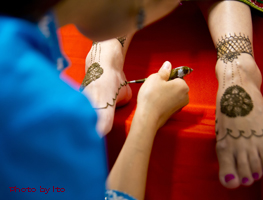BiNDU Henna Azko
1990年代に初めてヘナに出会い、独学で勉強。
2008年にインドにて文化としてのメヘンディを、2010年と2012年にイギリスにてアートとしてのメヘンディを学ぶ。
![]()
実は、一番最初にヘナに出会ったときの記憶を全く覚えていない。
大阪にいたころだから、1990年代だったのは間違いない。
最初は、手の形をしたビニールで出来たレースのようなものを手のひらに載せて、上からヘナペーストを塗りたくり、ぺらっと剥がしてステンシルのように残った絵柄を楽しむ、といったことをしていた。そのときのヘナペーストなどもどこで仕入れていたのか、なぜかまったく記憶にない。当時よく行っていたシンガポールだったかな。
そこから数年後、東京に行って初めてヘナコーンの存在を知った。
そしてそれがいわゆる「メヘンディ」だということも。
最初は、インド雑貨屋やインド現地で仕入れた市販のヘナコーンを使って描いていた。今では手作りのヘナコーンしか使わないが。
もっぱら自分の身体に描くばっかりで、たまに友人に練習台になってもらったりと。
 インドに行こう。
インドに行こう。
そう思って、2008年、しばらくデリーとラジャスタンでホームステイしながら、メヘンディのデザインを習ったり、結婚式の準備を手伝ったり、親戚友人一同に描いたりしながら、インドにおけるメヘンディの習慣を生活の中で体験。
2010年には、大好きなロンドンのヘナ・アーチストRiffatから直接指導を受ける。
2012年にはブライダル・メヘンディを学ぶ。
2020年4月までは、東京でイベント関係に出没したり、インド人コミュニティやダンサーの方々を中心に活動。
2020年6月より、拠点を大阪に移し、メヘンディのオンライン講座も開始するなど、活動を続けている。
***** ご注意 *****
ブラック・ヘナをご存知でしょうか。
もし黒い色のヘナペーストがあれば、それは毛染め剤などの化学染料が入っているかもしれませんので、ご注意ください。それに含まれているPPDという化学物質は、人によってはただれて傷を残すことがあります。さらに、血液に入れば、肝臓や腎臓にダメージを与えることもあります。
BiNDU Hennaはブラック・ヘナを使いません。
良質の100%天然ヘナに天然のオイルとレモンを使って一つひとつ手作りでペーストを作っていますので、ご安心してメヘンディをお楽しみください。
BiNDU Henna
Henna artist: Azko
I first observed Mehndi in the 1990’s and learnt doing it by myself.
I learnt Mehndi from Indian culture in 2008, and learnt as an art in the UK during the year of 2010 and 2012.
I was born in Osaka.
I really don’t remember exactly when I saw Mehndi for the first time in my life.
I only can recall that I used to play with henna paste, when I was living in Osaka (in the 1990’s), using a plastic stencil sheet on a palm, which gives an instant design.
I’m not sure from where I used to get those henna pastes (it was probably from Singapore…?).
In the beginning of 2000, I went to Tokyo.
One day, a friend of mine got me a “henna cone” and she told me that it was also known as “Mehndi” in India.
In the beginning, I used ready-made henna cones from India to practice on my own body or ask my friends to be my guinea pigs (I’m not continuing to use this kind of henna cones anymore, but my original safe henna cones).
I suddenly decided to go to India to understand the real meaning of Mehndi.
In 2008, I stayed in Delhi and Rajasthan and learnt Mehndi from school, from wedding, and also by drawing for the local family members and friends.
In the year 2010, I went to London to take lessons from Riffat, who is my admiration of Henna Art.
In the year 2012, I again met Riffat to continue my study of Mehndi for wedding.
Until April 2020, I often participated in art and Indian festivals, and gave Mehndi services to the Indian communities and to dancers mainly in Tokyo metropolitan region.
In June 2020, I moved to Osaka, which is my hometown.
I’m continuing to work on Mehndi by offering online lessons on Mehndi art to the world.
